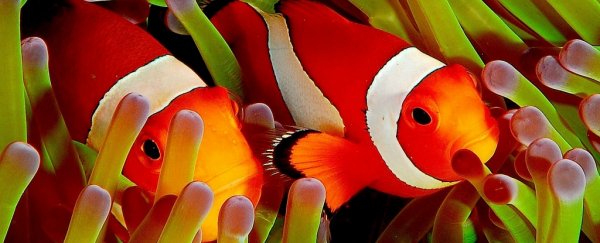When global warming is bleaching the ocean's coral, and our sunscreen is contributing to the decline of coral reefs, you could imagine that fish would be pretty territorial about whatever homes they have left.
But a new study has shown that clownfish are happy to share their anemones when times get tough and space is limited. Aww, thanks Nemo.
The study has found that not only do our favourite fish share their homes - there also isn't any increased aggression between roommates.
Because there are multiple species of clownfish, researchers from the University of Technology Sydney (UTS) in Australia found that the dominant species accept the subordinate species, and they all live in harmony. (We bet there are still arguments about whose turn it is to take out the rubbish though.)
The research is an important part of discovering how fish will survive with increased habitat degradation due to climate change and other human activities.
"We found that the number of clownfish species outnumbered host-anemone species, creating a situation where host anemones are often limited. Instead of competing for available hosts, clownfish cohabit anemones," says one of the UTS researchers, Emma Camp.
The team says things aren't all completely equal - when the anemone-sharing happens, the subordinate clownfish get pushed to the fringe, whereas the more dominant ones get to enjoy the more protected middle. Still, if there are only a small number of anemones and a high number of clownfish, this situation makes much more sense than having no home at all.
The study is giving scientists crucial insight into how fish will adapt to habitat destruction in the future. "Marine habitats are being lost globally and unfortunately the cost of that loss is not fully understood," says Camp.
"In many cases we will not know the true loss associated with habitat degradation until it is too late. Understanding biodiversity and how it is supported is therefore crucial in helping to preserve diversity and the natural ecosystem services provided, especially in what is a global centre of marine biodiversity," she adds.
Not only do clownfish have to deal with losing their homes, but movies like Finding Nemo and Finding Dory also put a huge strain on the wild population as clownfish are added to people's fish tanks. Back in 2003, when Finding Nemo came out, there was a severe drop in wild clownfish populations.
"Clownfish sales skyrocketed," University of Queensland researcher Carmen da Silva told The Huffington Post. "I think a lot of people fell in love with the character Nemo and they wanted one for their aquarium. There's nothing wrong with owning a marine fish in an aquarium but I think a lot of people didn't realise 90 percent of clownfish sold are taken from the wild."
To try and avoid the same thing happening with the new Finding Dory film, Australian researchers have set up a captive breeding program to keep up with demand for clownfish and hopefully avoid them being taken from the wild.
We hope that people can take a lesson from Finding Nemo, and avoid taking fish from their natural homes - and leave their homes alone while they're at it.
The research was published in Proceedings of the Royal Society B Biological Sciences.
UTS Science is a sponsor of ScienceAlert. Find out more about their research.
